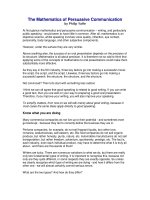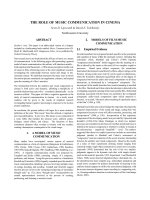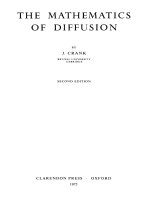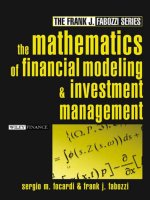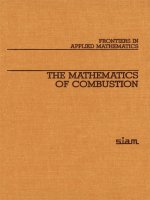128_Teaching the Mathematics of Music
Bạn đang xem bản rút gọn của tài liệu. Xem và tải ngay bản đầy đủ của tài liệu tại đây (3.12 MB, 16 trang )
Teaching the Mathematics
of Music
Rachel Hall
Saint Joseph’s University
Overview
• Sophomore-level course for math majors (nonproof)
• Calc II and some musical experience required
• Topics
–
–
–
–
–
–
Rhythm, meter, and combinatorics in Ancient India
Acoustics, the wave equation, and Fourier series
Frequency, pitch, and intervals
Tuning theory and modular arithmetic
Scales, chords, and baby group theory
Symmetry in music
Course Goals
•
Use the medium of musical analysis to
•
•
•
•
•
Explore mathematical concepts such as Fourier series and
tilings that are not covered in other math courses
Introduce topics such as group theory and combinatorics
covered in more detail in upper-level math courses
Discuss the role of creativity in mathematics and
the ways in which mathematics has inspired
musicians
Use mathematics to create music
Have fun!
Semester project
Each student completed a major project that
explored one aspect of the course in depth.
• Topics included
–
–
–
–
–
–
the mathematics of a spectrogram;
symmetry groups, functions and Bach;
Bessel functions and talking drums;
change ringing;
building an instrument; and
lesson plans for secondary school.
• Students made two short progress reports and a
15-minute final presentation and wrote a paper
about the mathematics of their topic. They were
required to schedule consultations throughout the
semester. The best projects involved about 40
hours of work.
Logarithms and music:
A secondary school math lesson
Christina Coangelo, Senior, 5 yr M. Ed. program
Math Content Covered
• Functions
– Linear, Exponential, Logarithmic,
Sine/Cosine, Bounded, Damping
– Graphing & Manipulations
• Ratios
Building a PVC Instrument
Jim Pepper, Sophomore, History major, Music minor
Predicted Pitch
Pitch
Desired Freq.
Actual Freq.
Difference
Actual
Length
Predicted length
Difference
48
48.25
130.81
132.715498
1.905498
47.59574391
48.25
0.654256
49
49.1
138.59
139.394167
0.804167
45.35126555
46.25
0.898734
50
50.1
146.83
147.682975
0.852975
42.84798887
43.23
0.382011
51
51
155.56
155.563492
0.003492
40.71539404
41
0.284606
52
52.05
164.81
165.290467
0.480467
38.3635197
37.75
-0.61352
53
53.05
174.61
175.11915
0.50915
36.25243506
36
-0.25244
54
54
185
184.997211
-0.00279
34.35675658
33.75
-0.60676
55
55
196
195.997718
-0.00228
32.47055427
32
-0.47055
56
56
207.55
207.652349
0.102349
30.69021636
31.5
0.809784
57
57.3
220
223.845532
3.845532
28.52431467
28
-0.52431
58
58.1
233.08
234.43211
1.35211
27.27007116
26.25
-1.02007
59
58.8
246.94
244.105284
-2.83472
60
59.85
261.63
259.368544
5
-2.26146
4
3
2
1
0
-1
-2
-3
-4
Difference
26.21915885 Frequency 25.25
-0.96916
24.72035563
0.279644
25
Series1
1
2
3
4
5
6
7
8
9
10
11
12
13
The Mathematics of Change Ringing
Emily Burks, Freshman, Math major
Symmetry and group theory
exercises
Sources:
J.S. Bach’s 14 Canons on the Goldberg Ground
Timothy Smith’s site:
/>Steve Reich’s Clapping Music
Performed by jugglers
/>
Bach’s 14 Canons on the Goldberg Ground
Bach composed
canons 1-4 using
transformations of
this theme.
• How are canons 1-4 related to the solgetto and to
each other?
• How many “different” canons have the same
harmonic progression?
• Write your own canons.
Canons 1 and 2
I(S)
S
RI(S) = IR(S)
R(S)
theme
retrograde
Canon #1
inversion
retrograde
inversion
Canon #2
Canons 3 and 4
I(S)
S
RI(S) = IR(S)
R(S)
retrograde
Canon #3
inversion
retrograde
inversion
Canon #4
The template
• How many other “interesting” canons can you
write using this template?
• (What makes a canon interesting?)
• Define a notion of “equivalence” for canons.
Steve Reich’s Clapping Music
Performer 1
Performer 2
• Describe the structure.
• Why did Reich use this particular pattern?
• Write your own clapping music.
Challenges
• Students’ musical backgrounds varied widely.
I
changed the course quite a bit to accommodate this.
• Two students did not meet the math prerequisite.
They had the option to register for a 100-level
independent study, but chose to stay in the 200-level
course. One earned an A.
For next time…
• Spend more time on symmetry and less on tuning
• Add more labs
• More frequent homework assignments
Resources
Assigned texts
• David Benson, Music: A Mathematical Offering
• Dan Levitin, This is Your Brain on Music
Other resources
• Fauvel, Flood, and Wilson, eds., Mathematics and
music
• Trudi Hammel Garland, Math and music:
harmonious connections (for future teachers)
• My own stuff
• Lots of web resources
• YouTube!
Learn more
• />(handouts and other resource materials)
• />(over 30 links, grouped by topic)
• />(my articles)
• Email me:
